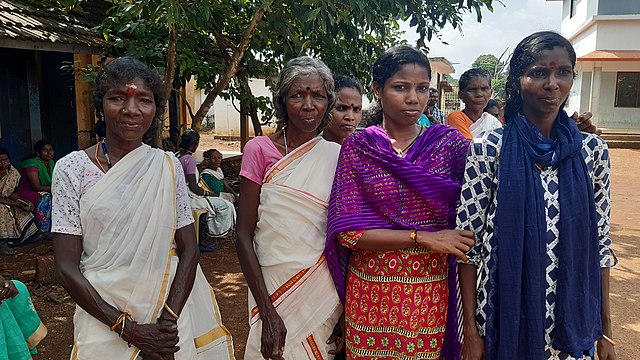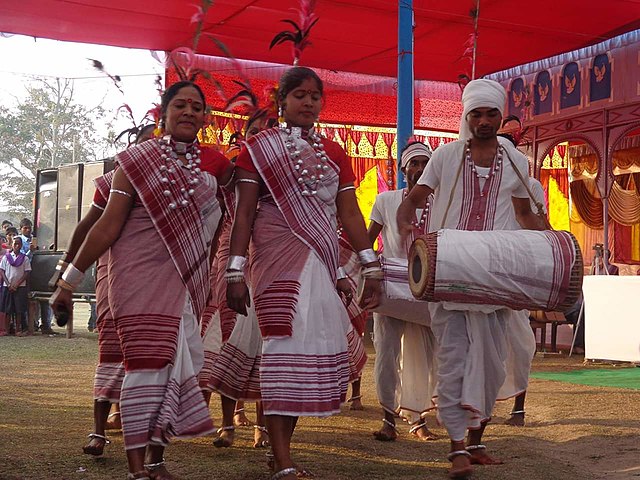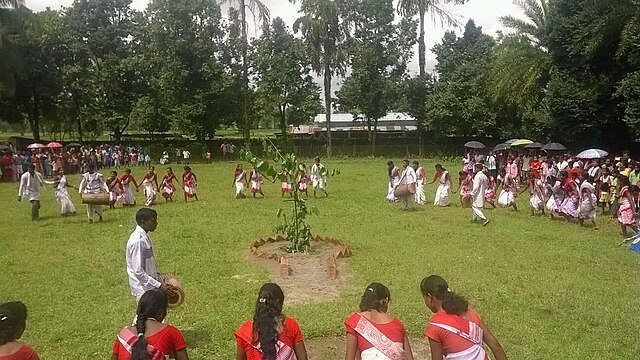The Adivasi are heterogeneous tribal groups across the Indian subcontinent. The term is a Sanskrit word coined in the 1930s by political activists to give the tribal people an indigenous identity by claiming an indigenous origin. The term is also used for ethnic minorities, such as Chakmas of Bangladesh, Bhumiputara Khasas of Nepal, and Vedda of Sri Lanka. The Constitution of India does not use the word Adivasi, instead referring to Scheduled Tribes and Janjati. The government of India does not officially recognise tribes as indigenous people. The country ratified the International Labour Organization (ILO) Convention 107 on Indigenous and Tribal Peoples of the United Nations (1957) and refused to sign the ILO Convention 169. Most of these groups are included in the Scheduled Tribe category under constitutional provisions in India.
Women of Paniya community in Kerala
Gondi women in Umaria district, India
Cultural dance of the Kurukh Oraon community, one of tribes in Central and Eastern India
A Jarawa themed museum, showing casual clothing styles. The Jarawa are one of the indigenous tribes of the Andaman Islands in South Asia
The Tea-garden community is a term for a multiethnic, multicultural group of tea garden workers and their descendants in Assam. They are officially referred to as Tea-tribes by the government of Assam and notified as Other Backward Classes (OBC). They are the descendants of peoples from multiple tribal and caste groups brought by the British colonial planters as indentured labourers from the regions of present-day Jharkhand, Odisha, Chhattisgarh, West Bengal and Andhra Pradesh into colonial Assam during the 1860-90s in multiple phases to work in tea gardens. They are found mainly in those districts of Upper Assam and Northern Brahmaputra belt where there is a high concentration of tea gardens, like Kokrajhar, Udalguri, Sonitpur, Biswanath,Nagaon, Golaghat, Jorhat, Sivasagar, Charaideo, Dibrugarh, Tinsukia, and Lakhimpur. There is a sizeable population of the community in the Barak Valley region of Assam as well in the districts of Cachar, Karimganj and Hailakandi. The total population is estimated to be around 7 million, of which an estimated 4.5 million reside in residential quarters built inside 799 tea estates spread across tea-growing regions of Assam. Another 2.5 million reside in the nearby villages spread across those tea-growing regions. They speak multiple languages, including Sora, Odia, Assam Sadri, Sambalpuri, Kurmali, Santali, Kurukh, Kharia, Kui, Chhattisgarhi, Gondi and Mundari. Assam Sadri, distinguished from the Sadri language, serves as lingua franca among the community.

Tea Garden workers in a tea garden near Kalaigaon, Darrang district
Non-native languages of Assam, 2011 census
Sarnaism
Karam Festival in North Lakhimpur, Assam








